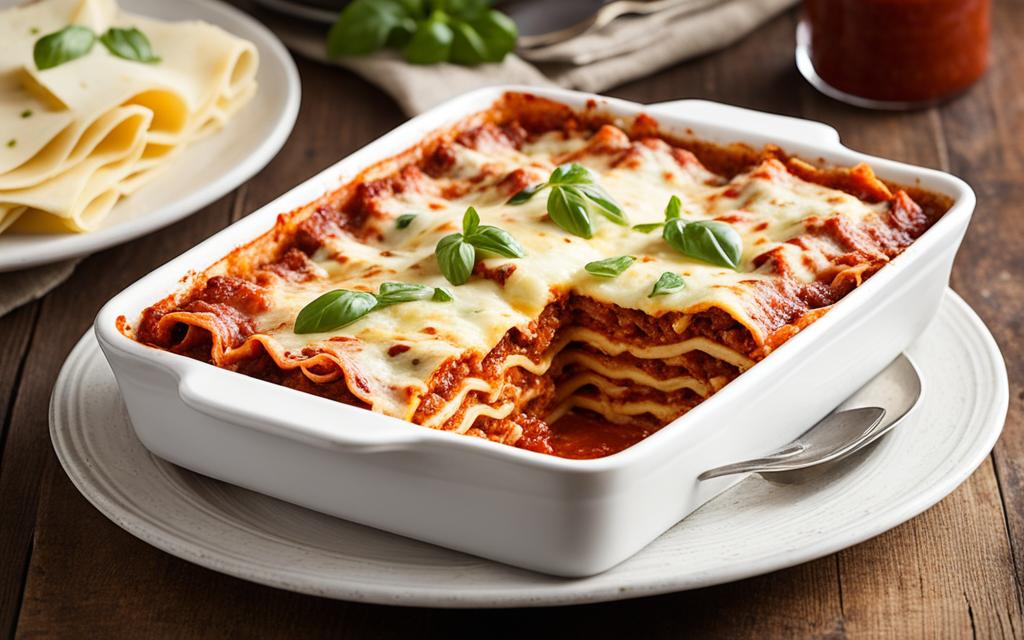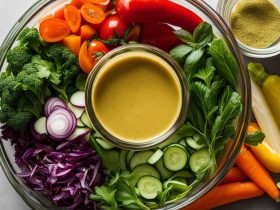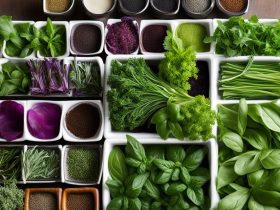Experience the authentic taste of Italy with this homemade lasagna recipe. Made from scratch, this classic Italian dish features layers of silky pasta, homemade beef ragu, and creamy bechamel sauce. Discover the secrets to achieving the rich flavors of Italian cuisine and indulge in the ultimate comfort food.
Key Takeaways:
- Homemade lasagna offers the authentic taste of Italy.
- Layers of pasta, beef ragu, and bechamel sauce create a rich and flavorful dish.
- Italian cuisine is known for its traditional recipes.
The Elements of a Classic Italian Lasagna
A traditional Italian lasagna consists of three key elements: ragu or meat sauce, pasta, and bechamel sauce. The combination of these components creates a harmonious and flavorful dish that is loved worldwide.
Ragu: The ragu is the soul of a classic Italian lasagna. It is a rich and savory meat sauce made with a combination of beef and pork simmered in a flavorful tomato base. The slow cooking process allows the flavors to meld together, creating a deep and robust sauce.
Pasta: When it comes to pasta, fresh lasagna sheets are recommended for an authentic and superior texture. Homemade pasta takes the lasagna to a whole new level, but if you prefer convenience, store-bought fresh lasagna sheets can also be used.
Bechamel Sauce: The bechamel sauce is a creamy white sauce that adds richness and depth to the lasagna. Unlike ricotta cheese-based versions, a classic Italian lasagna uses bechamel sauce. Made from a combination of butter, flour, milk, and seasoned with nutmeg, parmesan cheese, salt, and pepper, the bechamel sauce brings a luxurious touch to the dish.
These three elements work together to create a lasagna that is rich, flavorful, and deeply satisfying. Each layer of pasta is generously coated with ragu and bechamel sauce, ensuring a perfectly balanced bite in every serving.
To fully appreciate the beauty of a classic Italian lasagna, it’s important to understand the role each element plays and the care taken to create this beloved dish.
The Art of Making Ragu
The ragu is the heart of a lasagna and takes time to develop its rich flavors. It starts with a mixture of finely chopped carrot, celery, and onion sauteed in olive oil. Ground beef and pork are then added and browned to perfection. Red wine is used to enhance the depth of flavor. The sauce simmers for several hours until it becomes thick and concentrated, creating the ultimate comfort food.
Creating a delicious ragu is an art that reflects the Italian food culture and the essence of Italian comfort food. The combination of aromatic vegetables, tender meat, and simmering sauce results in a hearty and flavorful dish that will satisfy your cravings for traditional lasagna.
To start making ragu
To start making ragu, heat some olive oil in a large pot over medium heat. Add finely chopped carrot, celery, and onion to the pot and saute until they become translucent and fragrant. This trio of vegetables, known as a soffritto, provides a solid foundation of flavors for the sauce.
“The combination of aromatic vegetables, tender meat, and simmering sauce results in a hearty and flavorful dish that will satisfy your cravings for traditional lasagna.”
Once the vegetables are cooked, it’s time to add the meat. Ground beef and pork are commonly used in traditional ragu recipes. Brown the meat in the pot, breaking it up into small pieces using a spoon or spatula. This step adds depth and richness to the sauce, as the meat caramelizes and develops a complex flavor profile.
red wine is added to the pot
To further enhance the taste, red wine is added to the pot. The acidity of the wine helps tenderize the meat and infuses the sauce with a subtle tang. It’s important to allow the wine to reduce and cook off its alcohol content before proceeding.
After the wine has reduced, tomato sauce or crushed tomatoes are added to the pot. The tomatoes provide a vibrant and tangy base for the ragu. Season the sauce with salt, pepper, and herbs like bay leaves, thyme, and oregano. The sauce is then left to simmer on low heat for several hours to allow the flavors to meld together and the sauce to thicken.
Throughout the simmering process, the aroma of the ragu fills the kitchen, creating a mouthwatering anticipation for the finished lasagna. The slow cooking time allows the sauce to develop its rich flavors and ensures that each bite is packed with comforting deliciousness.
Once the ragu is ready, it’s time to assemble the lasagna, layering the sauce with pasta sheets and bechamel sauce. The homemade ragu provides the foundation for a truly authentic and satisfying lasagna experience.
Now that you understand the art of making ragu, you’re ready to create your own lasagna masterpiece. The next section will guide you through the process of creating perfect homemade pasta, another essential element of traditional Italian lasagna.

Creating Perfect Homemade Pasta
While dried lasagna sheets can be used, nothing beats the taste and texture of homemade pasta. Making your own pasta may seem intimidating, but it’s worth the effort. Combine flour and eggs to create a smooth dough, then roll it out and cut into thin sheets. If you prefer a shortcut, fresh lasagna sheets can be easily found in stores. Using fresh pasta ensures a superior taste and texture in your lasagna.
“Homemade pasta adds a unique touch to your lasagna, elevating it to a whole new level of deliciousness!”
Tips for Making Homemade Pasta:
- Use a pasta machine – This will help you roll out the pasta dough evenly and achieve the desired thickness for your lasagna sheets.
- Rest the dough – After preparing the pasta dough, let it rest for at least 30 minutes. This allows the gluten to relax, resulting in a more tender and easier-to-work-with dough.
- Roll the pasta to desired thickness – Depending on your preference, you can roll the pasta sheets thinly for a delicate lasagna or thicker for a heartier texture.
- Cook pasta sheets briefly – If using homemade pasta sheets, blanch them in boiling water for a few seconds before layering them in your lasagna. This ensures that the pasta cooks perfectly during the baking process. If using store-bought fresh lasagna sheets, follow the cooking instructions on the package.
| Benefits of Homemade Pasta | Store-Bought vs. Homemade |
|---|---|
| Elevates the taste and texture of lasagna |
|
| Allows for customization |
|
Mastering the Bechamel Sauce
A traditional Italian lasagna is not complete without a velvety bechamel sauce. Unlike Italian-American versions that use ricotta cheese, classic Italian lasagna relies on this creamy sauce to add richness and depth to the dish. Making bechamel sauce from scratch is simple and will elevate your lasagna to a whole new level of deliciousness.
- Melt the butter: Start by melting butter in a saucepan over medium heat. Allow it to melt completely, ensuring it doesn’t burn.
- Create a paste: Once the butter has melted, stir in flour to create a smooth paste. This mixture is known as a roux and serves as the base for the bechamel sauce.
- Gradually whisk in milk: Slowly pour in the milk while continuously whisking the mixture to prevent lumps from forming. Keep whisking until the sauce thickens and becomes smooth, usually 5-10 minutes.
- Season to taste: Add a pinch of nutmeg for a subtle warmth, followed by grated parmesan cheese, salt, and pepper. These seasonings will enhance the flavors and complement the other ingredients in the lasagna.
With just a few simple steps, you can create a creamy, luxurious bechamel sauce that will take your classic Italian lasagna to new heights. The silky texture and delicate flavors of the sauce will beautifully coat each layer of pasta, meat sauce, and cheese, resulting in a truly authentic and indulgent dish.
A Quote to Inspire:
“Bechamel sauce is the crown jewel of Italian lasagna. Its velvety texture and delicate flavors bring harmony to the dish, creating a symphony of taste with each bite.” – Chef Giovanni Rossi
| Benefits of Bechamel Sauce in Lasagna |
|---|
| 1. Creamy and velvety texture |
| 2. Adds richness and depth to the dish |
| 3. Balances the flavors of the other ingredients |
| 4. Creates a smooth and cohesive lasagna |
Assembling the Perfect Lasagna
Assembling a lasagna is the fun part. Start with a layer of ragu at the bottom of the baking dish, then add a layer of pasta sheets. Repeat the layers of ragu, bechamel sauce, and pasta, alternating until all the ingredients are used. The final layer should be pasta topped with a generous amount of bechamel sauce. Sprinkle with mozzarella cheese for a gooey, golden crust.
Creating the perfect lasagna requires layering each component carefully to achieve harmonious flavors and textures.
Here’s a step-by-step guide to assembling your homemade lasagna:
- Preheat the oven to 375°F (190°C) and lightly grease a baking dish.
- Spread a thin layer of ragu sauce on the bottom of the dish to prevent the noodles from sticking.
- Place a layer of pasta sheets on top of the ragu, slightly overlapping each sheet.
- Add another layer of ragu sauce, spreading it evenly over the pasta sheets.
- Pour a layer of bechamel sauce over the ragu, ensuring complete coverage.
- Repeat the layers of pasta, ragu, and bechamel sauce until all the ingredients are used. Aim for at least three layers.
- For the final layer, use pasta sheets and generously pour bechamel sauce over the top.
- Sprinkle shredded mozzarella cheese on the final layer of bechamel sauce.
Once you’re satisfied with the layers, cover the baking dish with aluminum foil and bake in the preheated oven for approximately 45 minutes. Remove the foil and continue baking for an additional 10 to 15 minutes, or until the cheese is melted and bubbling.
Before serving, allow the lasagna to cool for a few minutes to set. This will ensure that the layers hold together when cut. Serve the lasagna as a main course, accompanied by a fresh salad and crusty bread.
Cooking and Serving the Lasagna
Once assembled, the lasagna is baked in the oven until bubbling and golden. The cooking time is approximately 45 minutes, allowing the flavors to meld together and the cheese to melt. After removing from the oven, let the lasagna cool for a few minutes to set before serving.
The lasagna can be served as a main course, accompanied by a fresh salad and crusty bread. The combination of flavors and textures in this classic Italian dish will transport you to the heart of Italy, where food is not just sustenance, but a celebration of culture and tradition.
“Lasagna is a dish that brings people together around the table. It represents the warmth and hospitality of Italian food culture, where each bite tells a story of tradition and love.”
With its layers of rich ragu, creamy bechamel sauce, and tender pasta, this lasagna is a true representation of classic Italian cuisine. Serve it with a smile and watch as your guests savor every bite, appreciating the authentic flavors and the nostalgia it brings.
Tips for Serving:
- Cut the lasagna into neat portions before serving for easy plating.
- Garnish with fresh basil or parsley for a touch of vibrant color.
- Pair with a glass of red wine to complement the robust flavors of the dish.
Prepare to be transported to Italy with every forkful of this comforting and flavorful lasagna. Whether you’re hosting a family dinner or a gathering of friends, this classic Italian dish is sure to impress and leave everyone craving for more.
Tips and Variations
Enhance your lasagna experience with these tips and variations:
- Freeze the beef ragu in advance to save time on the day of preparation. This allows the flavors to develop and deepens the taste of the ragu sauce.
- Use parmesan cheese in the bechamel sauce for a classic Italian flavor. Alternatively, add gruyere or fontina cheese for an indulgent twist.
- Make your own pasta for a truly authentic taste and texture. Roll out fresh lasagna sheets using a pasta maker or by hand.
- Watch step-by-step photos or video for guidance on how the ragu and bechamel sauce should look. This visual reference will help you achieve the desired consistency and thickness.
- Consider using no-boil lasagna noodles if desired. These convenient noodles can be used directly in the lasagna without precooking, saving time and effort. Follow the package instructions for best results.
With these tips and variations, you can elevate your lasagna to new heights and fully embrace the Italian food culture and the authentic taste of Italy.
Conclusion
Authentic homemade lasagna is the epitome of classic Italian cuisine, offering a truly delicious and comforting taste of Italy. By following traditional techniques and using high-quality ingredients, you can recreate the flavors and experience the rich food culture from the comfort of your own kitchen.
Whether you choose to make your own fresh pasta or opt for store-bought lasagna sheets, the magic lies in the carefully crafted layers. The combination of flavorful ragu, velvety bechamel sauce, and perfectly cooked pasta creates a harmonious symphony of flavors that will transport your taste buds straight to Italy.
Indulge in the warmth and richness of this beloved dish, relishing every bite as you savor the authentic taste of Italy. Whether shared with loved ones or enjoyed as a satisfying solo meal, classic homemade lasagna is a testament to the culinary heritage and passion for good food that Italy is known for.
FAQ
Can I use dried lasagna sheets instead of making my own pasta?
Yes, dried lasagna sheets can be used as a substitute for homemade pasta. However, using fresh lasagna sheets will result in a superior taste and texture.
How long should I bake the lasagna?
The lasagna should be baked in the oven for approximately 45 minutes until bubbling and golden.
Can I freeze the beef ragu in advance?
Yes, you can freeze the beef ragu in advance to save time on the day of preparation.
What type of cheese can I use in the bechamel sauce?
You can use parmesan cheese in the bechamel sauce for a classic taste. Alternatively, you can add gruyere or fontina for extra indulgence.
How should the ragu and bechamel sauce look?
You can refer to step-by-step photos or videos for guidance on how the ragu and bechamel sauce should look.
Can I use no-boil lasagna noodles?
Yes, you can use no-boil lasagna noodles if desired. Simply follow the package instructions for best results.
What can I serve with the lasagna?
The lasagna can be served as a main course, accompanied by a fresh salad and crusty bread.










Leave a Reply